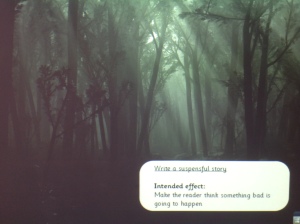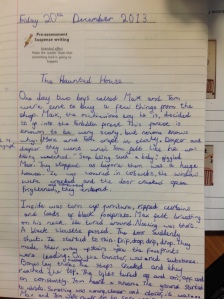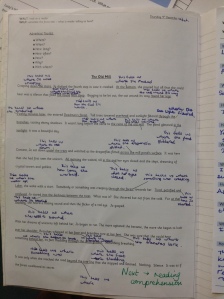This post follows on from the first in this three-part series which talks through a successful Talk for Writing unit.
Following on from the imitation work of reading as a reader activities and then reading as a writer during toolkit construction (all explained here), we then began to create save-it boxes – banks of sentences which would be drawn upon in innovation sessions. After teachers had picked specific parts of the toolkit on which to focus, children looked through other texts and ‘magpied’, innovated and invented their own sentences which could be used during writing. Save it boxes generated collaboratively by the teacher and the class were then displayed on the working wall whilst children also had ideas saved in their literacy books, ready for writing.
After working on Writers’ Toolkits and save-it boxes as well as all of the sentence work that had been completed throughout the unit thus far, children were well prepared to innovate. During this unit, we used post-it notes to plan our innovated writing. Simply placing post-it notes with our new ideas over the original text map ensured sentence structures were maintained – the key to innovation. Children then created their own ‘post-it note plan’ ready for writing their version of the story. Teachers ensured that the different sentence types on which we had focused were explicitly modelled and picked from our banks of ideas on the working wall.
Each day during the innovation and invention phases we included short bursts of grammar or sentence work, usually as a ‘Jumpstart’ activity (a quick starter to a lesson). In the main, these were based on elements of their writing from the previous day that we had identified as needing focused work.
Having planned their writing in detail using the scaffold of the original text map, children then wrote a number of paragraphs per day. In this suspense unit, children wrote two lots of three paragraphs. During shared writing sessions, teachers made explicit reference to the Writers’ toolkit, modelling the writer’s thought processes by talking aloud the intention behind the various language choices made. We modelled from both the long and short versions of the focus text.
During every writing session, children related their analysis of their own work back to the toolkit – to the intended effect on the reader. In the image above, the class have been encouraged to self assess by identifying a particularly successful section of their story and to then explain how they wanted to make the reader feel at this point in their writing. As with shared writing, this meta-cognitive process requires clear modelling and explanation by the teacher. However, after their immersion in the suspense genre, their reading as a writer work and their subsequent internalisation of the Writers’ Toolkit, children were well prepared to relate their analysis of their own writing back to the intended effect. As well as highlighting a successful section of their story, children were also encouraged to identify a sentence or two which they felt could be made even better. After careful modelling of this process by the teacher, children would then have a second attempt at this part of their writing.
To give the children the opportunity to write an entire text in a single lesson we then planned a second innovation, changing the setting of the story. Writing was planned in the same way using post-it notes. Again, teachers and children made intentional use of the different sentence types we had worked on both in this unit and previous ones. Therefore, although children were sticking to the general structure of the text, they dropped in extra sentences where appropriate and effective. In their second innovation, many children were confident enough to move further away from the focus text, which in turn prepared them well for inventing.























